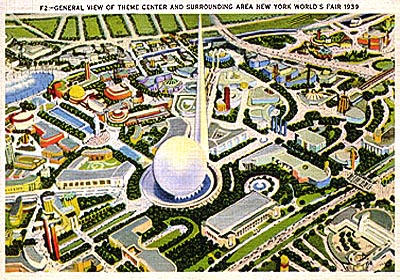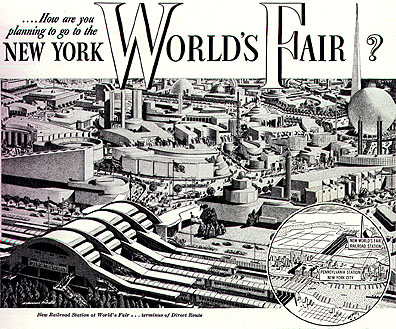 |
| 1939 New York World's Fair Map View |
The 1939–40 New York World's Fair, which covered the 1,216 acres (4.92 km2) ofFountain Lake , was the second largest American world's fair of all time, exceeded only by St. Louis's Louisiana Purchase Exposition of 1904. Many countries around the world participated in it, and over 44 million people attended its exhibits in two seasons. The NYWF of 1939–1940 was the first exposition to be based on the future, with an opening slogan of "Dawn of a New Day", and it allowed all visitors to take a look at "the world of tomorrow". According to the official New York World's Fair pamphlet,
"The eyes of the Fair are on the future – not in the sense of peering toward the unknown nor attempting to foretell the events of tomorrow and the shape of things to come, but in the sense of presenting a new and clearer view of today in preparation for tomorrow; a view of the forces and ideas that prevail as well as the machines. To its visitors the Fair will say: "Here are the materials, ideas, and forces at work in our world. These are the tools with which the World of Tomorrow must be made. They are all interesting and much effort has been expended to lay them before you in an interesting way. Familiarity with today is the best preparation for the future.'"
Planning
In 1935, at the height of the Great Depression, a group of New York City retired policemen decided to create an international exposition to lift the city and the country out of depression. Not long after, these men formed the New York World's Fair Corporation, whose office was placed on one of the higher floors in the Empire State Building. The NYWFC elected former chief of police Grover Whalen as the president of their committee. The whole committee consisted of Winthrop Aldrich, Mortimer Buckner, Floyd Carlisle, John J. Dunnigan, Harvey Dow Gibson, Mayor Fiorello La Guardia, Percy S. Straus, and many other business leaders.
Over the next four years, the committee planned, built, and organized the fair and its exhibits, with countries around the world taking part in creating the biggest international event since World War I. Working closely with the Fair's committee was Robert Moses, New York City Parks Commissioner, who saw great value to the City in having the World's Fair Corporation (at its expense) remove a vast ash dump in Queens that was to be the site for the exposition, and turn the area into a City park after the exposition closed.
Edward Bernays directed public relations of the fair in 1939, which he called 'democricity'. Grover Whalen, a public relations innovator, saw the Fair as an opportunity for corporations to present consumer products, rather than as an exercise in presenting science and the scientific way of thinking in its own right, as Harold Urey,Albert Einstein and other scientists wished to see the project."As events transpired," reported Carl Sagan, whose own interest in science was nevertheless sparked by the Fair's gadgetry, "almost no real science was tacked on to the Fair's exhibits, despite the scientists' protests and their appeals to high principles."
Promotion of this great event took many forms. In 1938, the Brooklyn Dodgers, New York Giants, and New York Yankees baseball teams did their part to promote the upcoming fair by wearing patches on their jerseys featuring the Trylon, Perisphere, and "1939" on their left sleeve.Howard Hughes flew a special World's Fair flight around the world to promote the fair in 1938.
While the main purpose of the fair was to lift the spirits of the United States and drive much-needed business to New York City, it was also felt that there should be a cultural or historical association. It was therefore decided that the fair opening would correspond to the 150th anniversary of George Washington's first inauguration as President of the United States.
 |
| 1939 New York World's Fair View |
 |
| 1939 New York World's Fair View |
 |
| 1939 New York World's Fair View |



 Posted in:
Posted in: 



